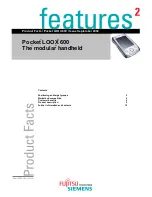
Product Facts · Pocket LOOX 600 · Issue September 2002
Page 6 of 11
Bluetooth
Bluetooth
TM
is designed as a short-range (10 – 100m) cable replacement technology linking multiple devices wirelessly
for synchronization, data transmission and file transfer. Furthermore it allows Bluetooth
TM
equipped devices to access
the LAN or Internet quickly and easily. Pocket LOOX has an internal Bluetooth module with a range of 100m.
More information like White Papers can be found under:
http://www.fujitsu-siemens.com/wireless
Interfaces
The Pocket LOOX comes with various interfaces such as an integrated microphone and loudspeaker as well as the
stereo headphone connector - and of course an infrared port and the cradle connector. With help of the standard USB or
optional serial cable you are able to connect the Pocket LOOX to your PC.
Infrared
The Pocket LOOX comes with a built-in Infrared (IrDA) interface as standard. This allows wireless data transfer, e.g. to
desktop computers and notebooks, or communication with other peripheral devices such as printers, beamers or mobile
phones
.
Compact Flash (CF) Card slot
Above all, the Pocket LOOX sports a CF Card slot type II and a SD/MMCard slot (MultiMediaCard). The CF Card slot,
originally made for flash memory cards, can be compared to the PCMCIA slots on a laptop. With an adapter, they are
even interchangeable – with the difference that the form factor is less than half the size and thus much lighter. As they
are meant for battery operated PDAs, they use power much more efficient as PCMCIA cards. Several types of CF Cards
such as WLAN Cards and IBM Microdrive (1GB) are available. Of course, flash memory cards for memory expansion still
work as well.
Secure Digital (SD) / Multimediacard (MMCard) slot
The SD Card is mainly used in digital cameras or MP3 players. With a much smaller form factor than CF Cards, these
storage cards - the SD/MMCards - are the ideal way of exchanging and storing information.
Display
Pocket LOOX comes with a bright 240x320 pixel 65.536-colour reflective TouchScreen, which is intended for use with a
stylus or with fingertip and offers best indoor and outdoor usage.
Operating System
Pocket LOOX is based on the latest Microsoft operating system for PDAs, the Pocket PC 2002 software. This very
powerful OS has become a standard in PDA operating systems. Its constantly growing market share and the large
developer community is ensuring compatibility and many software solutions. Not that the standard software offering
leaves much to complain about. Pocket Outlook, Pocket Word and Pocket Excel will give you a small office away from
the office. Together with terminal client functionality and server based synchronization, it gives the user a fully functional
mobile office in a handy form factor.
Accessories
Additional to the standard delivery package, which includes a protection bag, cradle, USB cable and TouchScreen stylus,
there are several optional accessories available. For instance a second battery plug-on, a GSM/GPRS plug-on module
(as of Q4/2002), various CF Cards like wLAN and IBM microdrive as well as a foldable keyboard and sync cables to
mention just a few.
Security
It would be difficult to deploy a business application on a mobile device throughout an organization without any thought to
security such as a password that is automatically set when powered off. Pocket LOOX is designed with this feature for
which there is no back door – no way for someone to get access to the applications or data on the device without the
power-on password as long as the password is set.
In addition to device password protection, mobile device security includes a documented security policy in the enterprise,
authentication, encryption, public key infrastructure (PKI), virtual private networking, and protection against viruses.
There are many security offerings for Pocket PCs, from Microsoft and third parties.
Flash-able ROM.
Organizations deploying large numbers of mobile devices should evaluate the cost and benefits of devices that store the
operating system and core applications on an updateable, “flash” ROM chip. While this may add a little more to the cost
of each device, updates to the operating system and core applications can be remotely installed in the field without
having to swap or replace devices.
Fujitsu Siemens Computers will offer customized devices for projects/companies as an additional service. Therefore the
customer will receive one device as the other, fitting to his needs after consideration of his needs and specifications.
In some cases, systems management, virus protection and custom applications may be placed in flash ROM so that
even if a user does a hard reset of the device by removing all batteries, these applications are not lost or deactivated.











